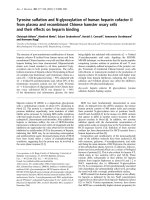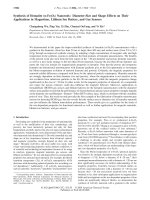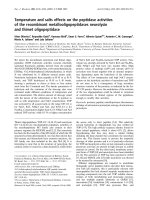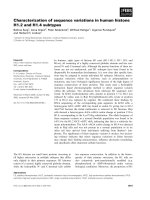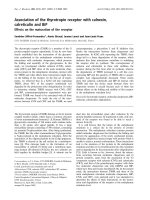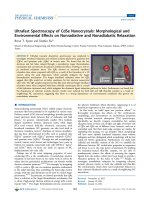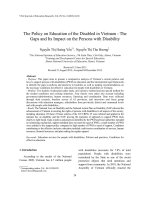Characterization of CD137 ligand mediated human monocyte differentiation and their effects on t cell activities
Bạn đang xem bản rút gọn của tài liệu. Xem và tải ngay bản đầy đủ của tài liệu tại đây (4.07 MB, 196 trang )
CHARACTERIZATION OF CD137 LIGAND
MEDIATED HUMAN MONOCYTE
DIFFERENTIATION AND THEIR EFFECTS ON
T CELL ACTIVITIES
SHAQIREEN D/O KWAJAH M. M.
(B.Sc (Hons), NUS)
A THESIS SUBMITTED FOR THE DEGREE OF
DOCTOR OF PHILOSOPHY
DEPARTMENT OF PHYSIOLOGY
YONG LOO LIN SCHOOL OF MEDICINE
NATIONAL UNIVERSITY OF SINGAPORE
2010
i
ACKNOWLEDGEMENTS
I am deeply thankful to my supervisor, Associate Professor Herbert Schwarz,
for his constant help, guidance and invaluable advices which has enabled me
to develop an understanding for the project. I truly appreciate the
encouragement and support that he has given me throughout the course of my
study.
Special thanks also go to my colleagues who have helped me in one way or
another; to Jeanette and Ariel, for their guidance and mentorship when I first
joined the lab; to Sun Feng, Doddy, Liang Kai and Weng Tong for their help
in the radioactive work; to Shao Zhe, Julia, Dongsheng, Nurulhuda and
Zulkarnain for the invaluable and fruitful discussions.
I would also like to express my gratitude to all past and present members of
the lab for their support and friendship and for the laughter that we shared
during my time in the lab. Lastly, I would like to thank my family for their
constant and unwavering support.
ii
TABLE OF CONTENTS
ACKNOWLEDGEMENTS
i
TABLE OF CONTENTS
ii
ABSTRACT
vii
LIST OF TABLES
ix
LIST OF FIGURES
x
LIST OF ABBREVIATIONS
xii
1. INTRODUCTION
1.1 The CD137 biology
1
1.1.1 The CD137 protein
1
1.1.2 Expression of CD137 and its role in immunity
2
1.1.3 CD137 and T cell responses
4
1.1.4 Immunotherapeutic potential of CD137
7
1.1.4.1 CD137 and tumour immunotherapy
7
1.1.4.2 CD137 and autoimmune diseases
8
1.2 The CD137 ligand biology
11
1.2.1 The CD137 ligand
11
1.2.2 Reverse signalling in the TNF superfamily
12
1.2.3 Expression of CD137L
14
1.2.4 Biological activities of CD137L signalling
14
1.2.4.1 CD137L stimulation and its role in
myelopoiesis
14
1.2.4.2 Effects of CD137L stimulation in
monocytes
16
1.2.4.3 Effects of CD137L stimulation in B cells
and DCs
18
iii
1.2.4.4 Effects of CD137L stimulation in T cells
20
1.2.5 CD137L signal transduction
21
1.3 Immune responses in CD137 / CD137L deficient mice
22
1.4 Myeloid cells, its differentiation and function
24
1.4.1 Macrophage classifications and funtions
25
1.4.2 Monocyte derived DCs
27
1.4.3 DC immunotherapy and its challenges
29
1.4.4 Interactions between T cells and myeloid cells
32
1.4.4.1 T cell co-stimulation
32
1.4.4.2 Suppressive action on T cells
34
1.5 Research objectives
35
2. MATERIALS & METHODS
2.1 Recombinant protein, antibodies and reagents
38
2.2 Protein immobilization on tissue culture plates
39
2.3 Cells and cell culture
40
2.3.1 Cell lines
40
2.3.2 Isolation of PBMCs, monocytes and T cells
40
2.3.3 In vitro generation of classical DCs and
macrophages
42
2.4 Monocyte – T cell co-culture systems
43
2.4.1 Syngeneic monocyte – T cell co-cultures
43
2.4.2 Allogeneic MLR
43
2.5 Quantification of cell proliferation
44
2.5.1 Thymidine incorporation
44
2.5.2 CFSE dilution 45
iv
2.6 Determining suboptimal OKT3 concentration
45
2.7 Flow cytometric analysis
46
2.7.1 CFSE staining
46
2.7.2 Surface marker expression
47
2.7.3 Intracellular cytokine staining
47
2.7.4 Identification of transcription factors
48
2.7.5 Death receptor and ligand expression
48
2.7.6 Apoptosis assay
49
2.8 Identification of cell type undergoing apoptosis
49
2.9 Functional assays
50
2.9.1 Phagocytosis
50
2.9.2 Endocytosis
50
2.9.3 Oxidative burst
51
2.10 Potential cytolytic activity of T cells
51
2.10.1 Perforin expression
51
2.10.2 Flow cytometry based killing assay
52
2.11 Determination of the importance of soluble factors
53
2.11.1 Transwell assays
53
2.11.2 Transfer of soluble factors
53
2.12 Neutralization assays
54
2.12.1 Neutralization of death inducing factors
54
2.12.2 Neutralization of H
2
O
2
by catalase
54
2.12.3 Cytokine neutralization
55
2.13 ELISA
55
2.14 Morphological changes
55
v
2.15 Statistics
56
3. RESULTS
3.1 CD137L mediated inhibition of PBMC subsets
57
3.1.1 CD137L activation inhibits PBMC proliferation
57
3.1.2 CD137L activation selectively induce T cell
apoptosis
59
3.1.3 CD137 mediated T cell apoptosis is dependent on
monocytes
61
3.1.4 CD137 induced, monocyte dependent T cell
apoptosis requires cell to cell contact
66
3.1.5 CD137 induced T cell apoptosis is independent of
CD95 and TRAIL
68
3.1.6 CD137 mediated T cell apoptosis is dependent on
ROS
75
3.2 Characterization of CD137L activated monocytes
77
3.2.1 CD137L signalling activates monocytes
77
3.2.2 CD137L signalling inhibits macrophage activities
78
3.2.3 CD137L activation promotes monocyte to DC
differentiation
86
3.2.4 CD137L DCs and classical DCs are functionally
different
94
3.3 Characterization of CD137L DC – T cell interactions
96
3.3.1 CD137L DC – T cell interactions are biphasic in
nature
96
3.3.2 CD137L DCs promote a pro-inflammatory T cell
phenotype
101
3.3.3
CD137L DC induce production of IFN-
and IL-13
but not IL-17 in naïve T cells
110
3.3.4 CD137L DCs increase the killing activity of CD8 T
cells
111
vi
3.4 Summary
118
4. DISCUSSION
4.1 CD137L activated monocytes and their inhibitory
activities on T cells
121
4.1.1 CD137 induces global inhibition of proliferation but
selectively mediates T cell apoptosis
121
4.1.2 CD137 induced T cell apoptosis requires monocyte
help
124
4.1.3 CD137 mediates T cell apoptosis independently of
the extrinsic pathway of apoptosis
126
4.1.4 ROS in T cells is important in mediating CD137
induced MDCD
129
4.1.5 Physiological significance of CD137 induced
MDCD
131
4.2 CD137L activation induces monocyte differentiation that
is stimulatory to T cells
134
4.2.1 CD137L signalling inhibits monocyte to
macrophage differentiation
134
4.2.2 CD137 promote monocyte to differentiate to
inflammatory DCs
138
4.2.3 CD137L DCs are phenotypically and functionally
different from classical DCs
141
4.2.4 CD137L DCs promote inflammatory T cells with a
high killing activity
144
4.2.5 The potential of using CD137L DCs as a tool in
human immunotherapy
147
4.3 Conclusion
149
4.4 Future work
151
REFERENCES
154
APPENDICES 171
vii
ABSTRACT
CD137 is a member of the tumour necrosis factor receptor (TNFR)
superfamily that is expressed on a variety of immune cells. Its activation
provides co-stimulatory signals to T cells and preferentially induces
proliferation and activation of CD8 T cells. Similar to CD137, its ligand
(CD137L), is also a membrane bound protein. Interaction between CD137 and
CD137L not only induces signalling into the receptor bearing cell, it also
initiates signalling into the ligand bearing cell. Hence, CD137 and its ligand
participate in bidirectional signalling and stimulation of CD137L which
results in signalling into ligand bearing cells has been termed as CD137
reverse signalling.
In human monocytes, CD137L signalling delivers a potent activating signal.
However, characterization of monocyte activation by CD137L has been
restricted to the production of pro-inflammatory cytokines, adherence and
morphological changes. This study shows that treatment of monocytes with
recombinant CD137 protein, which stimulates CD137L on monocytes, also
induces their differentiation to dendritic cells (DCs). This is evidenced by the
increased endocytic capacity, up-regulation of co-stimulatory molecules and
the ability to induce proliferation of naïve T cells. CD137 not only induces
monocyte to DC differentiation but also promotes DC maturation. These DCs
in turn inhibit development of regulatory T cells but induce T cell expression
of perforin, IFN-, IL-13 and IL-17 and T cells with a high killing activity.
Hence, recombinant CD137 protein as a sole factor can induce differentiation
of monocytes to mature, inflammatory DCs that have a potent T cell
viii
stimulatory capacity. As such, CD137 show potential in generating DCs that
can be used in human immunotherapy.
In contrast to these T cell stimulatory activities, CD137L stimulated
monocytes also induce T cell apoptosis. CD137 mediated, monocyte
dependent T cell apoptosis requires direct cell to cell contact and occurs
independently of the extrinsic pathway of apoptosis. Instead, ROS are
implicated in mediating T cell apoptosis. Hence, this study shows two
contrasting activities of CD137L stimulated monocytes that are temporally
separated; early induction of T cell apoptosis that is followed by its T cell
stimulatory function.
The pattern of CD137 induced, monocyte dependent T cell apoptosis show
close similarities to infection induced T cell attrition which occurs during a
number of viral infections. This early T cell apoptosis is suggested to be
beneficial to the subsequent development of pathogen specific immune
responses by (1) creating space in the lymphoid organ for expansion of
antigen specific T cells and (2) depleting low affinity cross reactive T cells
that can impede the development of proper immune responses. Hence, the two
phases of CD137L mediated monocyte activation seem to be geared towards
the development of an inflammatory immune response.
ix
LIST OF TABLES
1. List of antibodies
38
2. Volume of protein in tissue culture wells 40
x
LIST OF FIGURES
1.
Dual role of CD137 in immunotherapy 11
2.
Bidirectional signalling in CD137 / CD137L system 13
3.
CD137 mediated inhibition of PBMC proliferation 60
4.
CD137L activation selectively induces T cell apoptosis 62
5.
CD137 induced T cell apoptosis is dependent on monocytes
64
6.
CD137 induced monocyte dependent apoptosis affects CD4
+
and CD8
+
T cells equally
65
7.
CD137 induced T cell apoptosis requires contact between
monocytes and T cells
67
8.
CD137 treatment increases expression of death receptors on
T cells
70
9.
CD137 treatment increases expression of CD95L and
TRAIL on T cells
71
10.
CD137 mediated T cell apoptosis is independent of the
CD95 receptor / ligand and TRAIL / death receptor systems
74
11.
Inhibition of ROS completely blocks CD137 induced T cell
apoptosis
76
12.
CD137L signalling activates monocytes 79
13.
CD137L signalling suppresses macrophage functions 82
14.
CD137L signalling induces DC-like characteristics 85
15.
CD137 treated monocytes undergo morphological changes 87
16.
CD137 treated monocytes express markers typical of mDCs 91
17.
CD137 treated monocytes can induce T cell proliferation 95
18.
CD137L DCs produce inflammatory cytokines 97
19.
CD137L DC-T cell interaction occurs in two phases 100
20.
CD137L DCs reduce proportion of CD4
+
CD25
+
FOXP3
+
cells
103
xi
21.
CD137L DCs induce a pro-inflammatory T cell cytokine
profile
108
22.
CD137L DCs produce IL-23 109
23.
CD137L DCs induce Th1 and Th2 polarization 113
24.
CD137L DCs increase perforin expression in CD8
+
T cells 116
25.
CD137L DCs increase killing activity of CD8
+
T cells 117
26.
Involvement of ROS in CD137 induced T cell death 130
xii
LIST OF ABBREVIATIONS
7AAD
7 aminoactinomycin D
A23187
Calcium ionophore A23187
aa
Amino acid
ACAD
Activated T cell autonomous death
AICD
Activation induced cell death
Akt Protein kinase B
APC
Antigen presenting cell
Arg-1
Arginase-1
BSA
Bovine serum albumin
CD137L
CD137 ligand
CD30L
CD30 ligand
CD40L
CD40 ligand
CD95L
CD95 ligand
CFSE
Carboxyfluorescein diacetate succinimidyl ester
CHO
Chinese hamster ovary
CIA
Collagen induced arthritis
Cpm
Counts per minute
CTL
Cytolytic T cell
DC
Dendritic cell
DcR
Decoy receptor
DHR123
Dihydrorhodamine 123
DISC
Death inducing signalling complex
DR Death receptor
EAU Experimental autoimmune uveoretinitis
xiii
EDTA
Ethylenediamine tetraacetic acid
ELISA
Enzyme linked immunosorbent assay
ERK
Extracellular signal regulated kinase
FBS
Fetal bovine serum
FcR
Fc receptor
FDC
Follicular dendritic cell
FGF-2
Fibroblast growth factor 2
FOXP3
Foxhead P3
GM-CSF
Granulocyte macrophage colony stimulating factor
HCV
Hepatitis C virus
HIV
Human immunodeficiency virus
ICAM-1
Intercellular adhesion molecule-1
IDO
Indoleamine 2,3-dioxygenase
IFN
Interferon
IL
Interleukin
ILA
Induced by lymphocyte activation
imDC
Immature DC
IMDM
Iscoves modified Dulbecco’s medium
iNOS
Inducible nitric oxide synthase
iB
Inhibitor of
B
JNK
c-Jun N-terminal kinase
LCMV
Lymphocytic choriomeningitis virus
LFA1
Lymphocyte function-associated antigen 1
LPS Lipopolysaccharide
MAPK
Mitogen associated protein kinase
xiv
M-CSF
Macrophage colony stimulating factor
MDCD
Monocyte dependent T cell death
MDSC
Myeloid derived suppressor cell
MFI
Mean fluorescence intensity
MIP
Macrophage inflammatory protein
MLR
Mixed lymphocyte reaction
mTOR
Mammalian target of rapamycin
NOX
NADPH oxidase
OPG
Osteoprotegerin
OX40L
OX40 ligand
PBMC
Peripheral blood mononuclear cell
PBS
Phosphate buffered saline
PGE2
Prostaglandin E2
PHA
Phytohaemagglutinin
PI3K
Phosphoinositide 3-kinase
PKA
Protein kinase A
PMA
Phorbol myristate acetate
RBC
Red blood cell
rhTRAIL
Recombinant human TRAIL
ROS
Reactive oxygen species
SLE
Systemic lupus erythematosus
SRBC
Sheep red blood cell
TAM
Tumour associated macrophage
TCR
T cell receptor
Th
T helper
xv
TLR
Toll like receptor
TNF
Tumour necrosis factor
TNFR
Tumour necrosis factor receptor
TNFRSF9
TNFR superfamily 9
TRAIL
TNF-related apoptosis-inducing ligand
Treg
Regulatory T cell
INTRODUCTION
Introduction
1
This thesis focuses on the activities of CD137 ligand (CD137L) activation on
monocytes, a subtype of myeloid cells. Hence, this introduction gives an
overview of the protein of interest, CD137, and its interaction with its ligand.
The concept of reverse signalling will be addressed and current literature on
the effects of CD137 reverse signalling is highlighted. Further, a review on
the current knowledge of monocytes, their differentiation, function and
interactions with T cells is discussed. Lastly, the research objectives of the
thesis are presented that will be further elaborated in the results and discussion
section.
1.1 The CD137 biology
1.1.1 The CD137 protein
CD137 was originally termed 4-1BB and induced by lymphocyte activation
(ILA) in mice and humans, respectively. It is a member of the tumour necrosis
factor receptor family, specifically, superfamily 9 (TNFRSF9). This protein
was first identified in activated murine T lymphocytes. In mice, CD137 is a
13kb gene on chromosome 4 (Kwon and Weissman, 1989). The full length
cDNA of the human homologue was finally characterized in 1993 (Schwarz et
al, 1993). It is a type I transmembrane protein and the gene is located on
chromosome 1p36 with other members of the TNFR family (Schwarz et al,
1997).
The nucleotide sequence of CD137 is made up of eight exons and seven
introns and consists of a single long open reading frame which encodes a 256
Introduction
2
amino acid (aa) protein. The first 23 aa are characteristic of a signal peptide
which is followed by a cysteine rich extracellular domain, constructed from
six exons, a hydrophobic transmembrane domain and a cytoplasmic tail
(Vinay and Kwon, 2006). These features indicate that CD137 is a cell surface
protein. In humans, the CD137 gene codes for a 255 aa protein with two
potential N-linked glycosylation sites (Schwarz et al, 1997). This glycoprotein
can exist as a 30kD monomer or a 55kD dimer (Kwon et al, 1994). There is
60% sequence homology between the murine and human homologues of this
gene. In the cytoplasmic domain, five regions are conserved between mouse
and man suggesting that these regions might be important for the proper
functioning of the CD137 protein. Besides its expression as a receptor,
differential splicing of the gene can result in the production of a soluble form
of CD137 that is secreted into the extracellular environment (Setareh et al,
1995; Michel et al, 1998).
1.1.2 Expression of CD137 and its role in immunity
CD137 has been shown to be expressed on a number of immune cells. These
include T lymphocytes, monocytes, dendritic cells (DCs), follicular dendritic
cells (FDC), NK and NKT cells (Pollok et al, 1993; Schwarz et al, 1995;
Melero et al, 1998; Kienzle and von Kempis, 2000; Futagawa et al, 2002;
Pauly et al, 2002; Wilcox et al, 2002; Lindstedt et al, 2003; Choi et al; 2004).
Expression of CD137 on these primary cells, except for monocytes and FDCs,
is inducible and is activation dependent. On monocytes and FDCs, CD137 is
Introduction
3
expressed constitutively (Kienzle and von Kempis, 2000; Pauly et al, 2002;
Lindstedt et al, 2003).
The expression of CD137 on diverse immune cells also reflects the various
roles that CD137 has on immunity. Even so, most of the research on CD137
biology has focused on its activities on T cells which will be discussed in the
next section. Studies on the role of CD137 on the innate immune system have
been limited but these studies show that stimulation through CD137 promotes
a pro-inflammatory state (Vinay and Kwon, 2011).
On monocytes and DCs, CD137 activation induces pro-inflammatory cytokine
production (Kienzle and von Kempis, 2000; Futagawa et al, 2002) while its
expression on FDCs may help to co-stimulate B cell activation (Pauly et al,
2002). CD137 stimulation has also been shown to induce proliferation of NK
cells and their production of IFN- without increasing the cytolytic potential
of these cells. Rather, CD137 activated NK cells seem to be important in
enhancing cytolytic potential of CD8 T cells (Melero et al, 1998; Wilcox et al,
2002). These studies show that CD137 stimulation affects the immune
regulatory function of NK cells and that CD137 is important in mediating
cross talk between the innate and adaptive immune responses.
Apart from immune cells, CD137 expression has been reported on other cell
types. Drenkard et al have reported that CD137 is expressed on blood vessel
walls at sites of inflammation where CD137 is thought to facilitate the
extravasation of monocytes into the inflammatory tissues (Drenkard et al,
2007). Further, expression of CD137 has also been reported on neurons and
astrocytes with up-regulation of its expression when these cells are stimulated
Introduction
4
with fibroblast growth factor 2 (FGF-2) (Reali et al, 2003). Chondrocytes too
express CD137 in the presence of pro-inflammatory cytokines (von Kempis et
al, 1997).
CD137 expression has also been reported in several cancers such as in Reed-
Sternberg cells in Hodgkin’s lymphoma, rhabdomyosarcoma (personal
communication, Schwarz H.) and osteosarcoma (Lisignoli et al, 1998).
1.1.3 CD137 and T cell responses
Since the discovery of CD137, most of the research on CD137 biology has
focused on its activities in T cells. T cells are critical in mediating effective
adaptive immune responses. These cells require two types of signals to
function effectively. One important set of signal is received through the T cell
receptor (TCR) that recognizes specific peptide-MHC complex. The second
signal is usually mediated through co-stimulatory molecules. CD137 is one
such co-stimulatory molecule. CD137 expression on T cells is strictly
activation dependent and has been shown to provide co-stimulatory signals to
both CD4
+
and CD8
+
T cells, resulting in proliferation and cytokine
production (Pollok et al, 1993; Alderson et al, 1993; Hurtado et al, 1995).
Further, CD137 has been shown to inhibit activation induced cell death
(AICD) during restimulation of activated T cells by up-regulation of the anti-
apoptotic protein, Bcl-xL (Hurtado et al, 1997; Starck et al, 2005).
Within the T cell population, most of the studies on CD137 co-stimulation
have focused on the CD8 T cells. These studies have also shown that CD137
Introduction
5
preferentially promote proliferation and survival of CD8 T cells as compared
to CD4 T cells. In CD8 T cells, the ability of CD137 to increase the
expression of anti-apoptotic proteins, Bcl-xL and Bfl-1 contributes to the
increased survival of these cells (Lee et al, 2002; Laderach et al, 2002).
CD137 activation also leads to production of large amounts of interferon
(IFN) -and tumour necrosis factor (TNF) which eventually translates to an
enhanced cytolytic activity of the CD8 T cells (Shuford et al, 1997; Mittler et
al, 1999). The ability of CD137 co-stimulation to enhance CD8 cytolytic T
cell (CTL) activity has generated much interest in the possible use of agonistic
anti-CD137 monoclonal antibodies in tumour immunotherapy. This will be
further discussed in the next section.
Studies in CD4 T cells have been limited and contradictory. Some studies
showed that engagement of CD137 on naïve CD4 T cells promotes interleukin
(IL) -2 production and proliferation and suppresses cell death (Gramaglia et
al, 2000; Cannons et al, 2001). However, in a graft versus host disease model,
CD4 T cells were reported to undergo AICD upon CD137 stimulation (Kim et
al, 2004). Studies by Mittler et al further showed that anti-CD137 antibody
may promote anergy of CD4 T cells resulting in the suppression of humoral
immune responses towards sheep red blood cells (SRBC) in mice immunized
against the SRBC antigen (Mittler et al, 1999). Further discrepancies are
reported in CD4
+
CD25
+
regulatory T cells (Tregs). A study by Choi et al,
showed that CD137 inhibits the suppressive functions of Tregs and is
therefore immunostimulatory in nature (Choi et al, 2004) but another study
showed that CD137 co-stimulation induces proliferation of Tregs both in vitro
and in vivo. These expanded Tregs are functional and suppressive towards
Introduction
6
other T cells (Zheng et al, 2004). The reasons behind these differences have
yet to be resolved. However, most studies agree that CD137 generally does
have a stimulatory role on the immune system and suppressive functions were
mainly limited to CD4 T cells. This dual role of immune stimulation and
immune suppression by CD137 may explain the ability of anti-CD137
antibodies to eradicate tumours and to suppress autoimmune diseases. This
dual role of CD137 will be further discussed in the next section.
Studies which compared co-stimulation provided by CD137 to that provided
by CD28, a critical co-stimulatory molecule on T cells, showed that CD137
co-stimulation is independent of CD28. T cells from CD28 deficient mice
could proliferate and produce IL-2 in response to B cell lymphomas bearing
the CD137L (DeBenedette et al, 1997; Saoulli et al, 1998). In humans,
CD137 activation of CD28
-
T cells induced proliferation, production of
inflammatory cytokines and enhanced cytolytic activity (Bukczynski et al,
2003).
Even so, CD28 and CD137 can function synergistically to amplify T cell
responses. CD28 and CD137 have been shown to synergize in the induction of
IL-2 by T cells and to promote T cell survival and proliferation (Maus et al,
2002; Wen et al, 2002). Studies in CD28 and CD137 deficient mice show that
CD28 is important in the initial amplification of T cells while CD137 signals
are important in maintaining survival and responsiveness of T cells later in the
course of an immunological response (Bertram et al, 2002). Several studies
have looked at the synergistic effects of CD28 and CD137 and show that
activation of these two molecules enhanced T helper (Th) 1 responses. Hence
synergistic CD28 and CD137 effects help to maintain CTL responses and this
Introduction
7
may have implications for the therapeutic potential of CD137 (Kim et al,
1998; Li et al, 2003;Zhong et al, 2010; Tammana et al, 2010).
1.1.4 Immunotherapeutic potential of CD137
1.1.4.1 CD137 and tumour immunotherapy
CD137 signalling has been described to promote Th1 responses resulting in
increased production of IFN- and TNF as well as enhanced CTL responses. It
is not surprising then that CD137 agonists have generated much interest for
the development of treatments against tumours.
Consistent with in vitro findings, several studies in murine tumour models
have shown that administration of agonistic anti-CD137 antibodies resulted in
marked augmentation of tumour specific CD8 T cells responses, leading to the
regression of well-established tumours (Melero et al, 1997; Miller et al, 2002;
Wilcox et al, 2002). In a study by Melero et al, administration of anti-CD137
antibodies prevented the development of tumours in a sarcoma and
mastocytoma model while all mice treated with control antibodies developed
tumours. CD137 stimulation could also result in the regression of large,
vascularised tumours and these mice remained tumour free (Melero et al,
1997).
In an in vivo setting, CD137 seems to be important in eradicating tumours
once the tumour has been established. Activated, tumour specific T cells
would then express CD137 and systemically administered anti-CD137
antibodies can then activate the CD137 expressing T cells, enhancing the CTL
Introduction
8
activity and therapeutic potential of the cells. This was supported by studies
which showed that administration of antibodies late in the tumour model was
more beneficial than early initiation of anti-CD137 treatment (Miller et al,
2002). Further, in poorly immunogenic tumour models, administration of
tumour antigens was shown to synergise with anti-CD137 antibodies in
eradicating tumours, suggesting the importance of activation of T cells by
tumour antigens, before activation of CD137 can be an effective tool in
tumour immunotherapy (Wilcox et al, 2002; Ito et al, 2004; Li et al, 2007).
To date, fully human CD137 specific antibodies have been developed for
clinical trials (Lynch, 2008). However, the studies so far have been
unsuccessful due to side effects observed in patients. Most of the studies on
CD137 based tumour immunotherapy now focus on combinatorial therapy
using anti-CD137 antibodies and other immune activating antibodies such as
anti-CD28 and neutralizing anti-CTLA-4 antibodies (Tammana et al, 2010).
Other studies are concerned with development of recombinant proteins that
can target CD137 (Schabowsky et al, 2009; Zhong et al, 2010). It is hoped
that with these recombinant proteins deleterious effects of using antibodies in
humans can be overcome and a more effective CD137 tumour immunotherapy
can be developed.
1.1.4.2 CD137 and autoimmune diseases
CD137 has mainly been described to be co-stimulatory to T cells, hence its
development as a target in tumour immunotherapy. It would be expected then
that activation of CD137 may exacerbate autoimmune diseases. Paradoxically,
